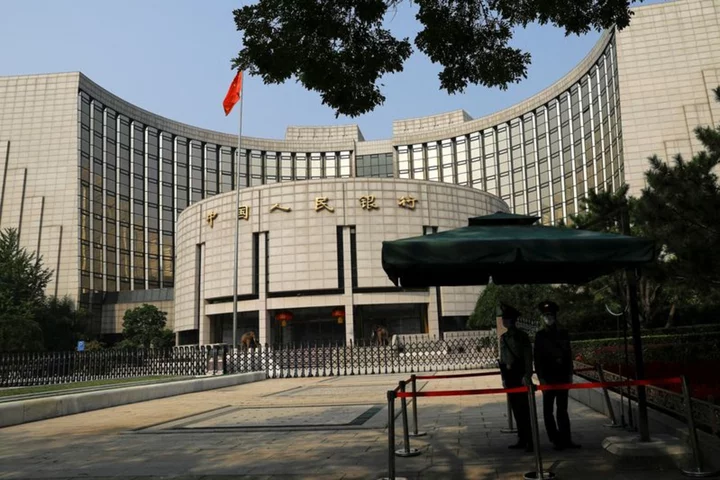By Jamie McGeever
A look at the day ahead in Asian markets from Jamie McGeever, financial markets columnist.
The People's Bank of China takes center stage on Tuesday with a near-certain interest rate cut, according to the expectations of investors, who are also trying to read the political tea leaves from U.S. Secretary of State Antony Blinken's visit to Beijing.
Trading volume across the region should pick up after U.S. markets were closed Monday for the Juneteenth holiday, and Malaysian trade, Japanese industrial output, and Hong Kong inflation data could all move asset prices in these countries.
All eyes, however, are on Beijing.
All 32 market watchers in a Reuters poll said the PBOC will cut key lending benchmarks for the first time in 10 months, as authorities battle to shore up a slowing recovery in the world's second-largest economy and ward off the threat of deflation.
The PBOC last week lowered short- and medium-term policy rates, paving the way for lower benchmark borrowing costs. Most poll participants expect the one-year loan prime rate to be cut by 10 basis points to 3.55%, and half said they forecast a deeper cut of at least 15 bps to the five-year LPR.
The weakness of recent economic data suggests the anticipated loosening of policy on Tuesday will be on the aggressive side and will be followed with further easing in the coming months.
Several major banks have cut their 2023 GDP growth forecasts for China to a 5.1% to 5.7% range from an earlier range of 5.5% to 6.3%.
Chinese stocks on Monday posted their biggest fall in two weeks, but the weakness was not confined to China. The MSCI World index came off last week's 14-month high, Japan's Nikkei lost 1%, and Hong Kong tech and the MSCI Asia ex-Japan index both had their biggest falls in three weeks.
That's the economic and market backdrop to U.S. Secretary of State Blinken's visit to Beijing, which ended on Monday with all the diplomatic courtesies and protocols one would expect, but with no major breakthrough for investors to cling to.
The two countries agreed to stabilize their rivalry so it doesn't veer into conflict, hailed "progress" and stressed the importance of a more stable relationship. But they appeared entrenched in their positions over everything from Taiwan to trade, including U.S. actions toward China's chip industry, human rights and Russia's war against Ukraine.
The yuan remains under pressure, anchored near seven-month lows against the dollar, and sentiment toward the Chinese currency will not have been boosted by the auspicious start to yuan-denominated trading in certain Hong Kong stocks on Monday.
The 24 companies that debuted the yuan-denominated stock trading scheme attracted a small fraction of their stocks' trading volume, as interest in using the new currency option was dwarfed by the Hong Kong dollar.
It is early days, of course, but perhaps another reminder that the yuan's road to internationalization is a very long one.
Here are key developments that could provide more direction to markets on Tuesday:
- China interest rate decision
- Japan industrial production (April)
- Malaysia trade (May)
(By Jamie McGeever; Editing by Lisa Shumaker)

